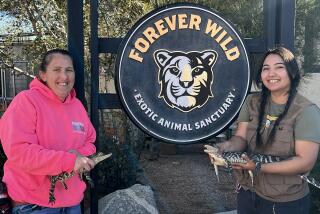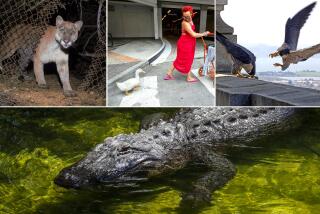Shiverin’ Alligators! : What’s a gang of ‘gators doing in Colorado? Scarfing fish guts and drawing curious crowds.
ALAMOSA, Colo. — High in the San Luis Valley of Colorado, the jagged snow-capped Sangre de Cristo Mountains to the east and the looming San Juan range to the west form a kind of cold sandwich.
Snow falls in buckets in this wide, flat valley and when the cold comes, it stays. There are nights when the mountains hug the cold tight until the temperature dips well below freezing.
On a very cold day here, all you can see in Erwin Young’s pond are dozens of pairs of craggy nostrils breaking the water’s surface. Here at 7,500 feet, where ski racks and tire chains are de rigueur, Young is growing gators.
They are the polar opposite of the proverbial snowball in hell, these snarly, crusty snappers, and they are 2,000 miles from the swamps and lazy rivers of home.
On a clear day, Young’s gator pond looks like a swarming pile of blown-out truck tires as alligators pile on top of each other two and three deep to soak up the sun. The pond looks out on stunning 14,000-foot peaks iced with snow year ‘round, but the gators aren’t here for the view. What brings them so far from home is 87-degree water that feels just like the bayou--and all the fish guts they can eat.
But how did they get here?
*
Young is a construction worker who started raising fish for commercial sale decades ago. Now he’s in his 50s and his fish business is doing well enough that he can lay down his nail gun and pursue fish farming full time. Much of Young’s success can be attributed to Rocky Mountain White Tilapia, a breed of freshwater perch he developed a few years ago on his 80-acre farm, north of Alamosa. The perch grow in the balmy water piped onto the property from 2,000-foot-deep artesian wells. He sells fresh fish to markets in New York, Chicago, Houston and Canada.
Young expects that as Tilapia--a standard now in restaurants across the country--becomes even more popular, grocery stores and fish markets will want fillets, and so he is building a processing plant. And hand in hand with a fish processing plant come bushels of leftover fish heads, innards and bones.
Young could have just ordered another dumpster. But he is a man who loves critters and has an eye for creative recycling, even if he would never call it that. Young is a man given to plaid shirts, gimme caps and few well-chosen words.
Fish guts don’t appeal to many, he’ll admit. “But,” he says, “alligators do love them.”
And so the alligators came to town.
And they are a sight.
Behind a 5-foot-tall chain-link fence just outside the fish production plant, a 12,000-square-foot pond holds an almost cartoonishly large collection of grizzled gators observing no rules of personal space or decorum. They crawl over each other with a crackling sound that reminds visitors to moisturize their elbows as soon as they get home. They hiss and occasionally snap at a passing fish or the errant duck unwise enough to land inside the fence. They sit with their mouths frozen open for minutes on end.
It is a sight few, even those from gator country, have ever seen. The only sizable alligator population outside of Florida, Louisiana and East Texas might have caused quite a commotion in other communities. But this is the San Luis Valley, where atmospheric conditions seem right for attracting the odd. Within a few miles on the valley floor are a buffalo ranch, the highest sand dunes in North America (a few adventurers ski on them in the winter), and groups of Hindus, Buddhists and even Denver Broncos fans.
Still, Young wasn’t sure how the neighbors would react to a group of alligators making a beachhead on land that has grown nothing more interesting than potatoes and wheat. So he kept his herd a secret at first. The first shipment came in a truck from Florida in 1986. The little gators were only about a foot long and could be handled by one set of hands. Young put them in tanks inside a large metal building, piped in the warm spring water that flows throughout his farm, locked the door and swore his employees to secrecy.
But the alligators grew, and Young bought more. Keeping 80 alligators a secret in the Rocky Mountains is about as easy as keeping a ski resort under wraps in the Everglades. Pretty soon word got out that there was something unusual going on in that building off Highway 17.
Interest intensified when Young began experimenting to see whether the gators could survive outside in the kind of weather that made Patagonia famous.
Young dug out a pond, enclosed it with chain-link fence and brought a few gators outside to experience a Colorado winter. That was more than three years ago, and since then all of the gators have moved outside and nearly all have survived.
The alligators are 7 years old now, and the biggest is 9 feet long. They thrive on plenty of dead fish, a high-protein commercial chow called Alligator Pellets and an occasional dead cow from a friendly neighbor. In the past two years, Young has lightened up on the raw beef, though.
“They were getting pretty vicious,” he says.
And Young wants nice alligators, not snappy ones, because he now has a new business--the country’s (maybe even the world’s) only mile-high $2-a-head alligator tour.
*
Before Young got his first alligator, he didn’t know much about nature’s most caricatured reptile. Now, he or one of his employees--always happy to take a break from the fish plant--are ready sources of information about alligators for curiosity seekers drawn to the farm by a simple sign on the highway: SLV Alligator Farm.
Some alligator facts:
They’re big.
Male alligators can grow to be 12 feet long and weigh as much as 600 pounds. An average male is a few feet taller than Shaquille O’Neal and weighs twice as much. Female gators can top 9 feet in length and weigh more than 160 pounds.
They’re shy. You’ll probably never see an alligator in the wild--unless you’re a tasty wild pig. Wild alligators sense people coming, duck underwater and swim away. The only time they attack is when frightened or threatened.
They’re not crocodiles. Alligators are related to crocodiles, but they are a whole other beast. The difference is mainly in the snout and teeth. Alligators look as if they made those adolescent trips to the orthodontist and dutifully wore their retainers. Crocodiles have overbites and dry skin.
*
When tour groups come to the alligator farm, they pass tanks of snowy white Tilapia, big fat catfish and Brazilian bullfrogs. Then they see the baby alligators--only four feet long but capable of taking off an arm. Then it’s outside to the main attraction, the alligator pond.
On the way, Young or one of his employees will reach into the maze of geothermal well-fed channels and grab a dead perch. Then he’ll gather the tour next to the fence where the alligators look like they’re napping, their eyes squinting in the sun. Young throws the fish over the fence and-- swomp --a half-dozen pairs of jaws shoot open and clamp down tight. It’s over before the tourists have a chance to squeal and one lucky alligator has a snack.
Young and his gators have been embraced by the Alamosa County Chamber of Commerce, which has been using a life-size character called Gus the Gator in promotions ever since it realized that mountain alligators are a big tourist draw.
“It’s incredible,” says the chamber’s executive director, Madrene McGowan. “We get calls from all over the U.S.”
Young, who had to go into the pond last year to retrieve a cache of eggs, knows that alligators’ speed and tails demand respect. Young was flanked by two hired hands with long poles when he went after the eggs. They beat the gators away as they approached, while Young collected dozens of eggs. Incubated under warm lights, none of the eggs hatched, although Young will try again next spring.
The U.S. Fish and Wildlife Service classified alligators as an endangered species in 1967 and alligator breeding farms opened to supply alligator meat and leather. Since then, the alligator population has rebounded and is classified now as only a threatened species, allowing limited hunting for commercial purposes. Alligators raised on commercial farms are usually killed before they grow bigger than four feet because young skin makes more desirable shoes, handbags and belts.
Since Young has no intention of turning his alligators into shoes, he’ll let them grow to ripe old alligator ages of 60, 70 and even 80.
That is, if they don’t run away.
Young has learned (the hard way) another alligator fact: Alligators can climb chain-link fences. Young caught one in the act once, going up and over the fence with the ease of a squirrel. He checks for tracks in the mud and snow every morning now, and occasionally finds a gator sunning on a nearby bank on the wrong side of the fence.
Then Young and four helpers each grab an alligator appendage and take the gator home. Young isn’t worried about his brood going too far. They need the warm water to survive.
And what do the neighbors think of rambling reptiles?
“We haven’t asked and they haven’t told us,” Young says.
More to Read
Sign up for The Wild
We’ll help you find the best places to hike, bike and run, as well as the perfect silent spots for meditation and yoga.
You may occasionally receive promotional content from the Los Angeles Times.






